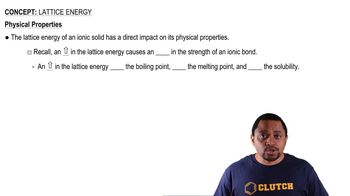When lithium iodide (LiI) is dissolved in water, the solution becomes hotter. b. What can you conclude about the relative magnitudes of the lattice energy of lithium iodide and its heat of hydration?
Ch.13 - Solutions
Chapter 13, Problem 37
Silver nitrate has a lattice energy of -820 kJ/mol and a heat of solution of 22.6 kJ/mol. Calculate the heat of hydration for silver nitrate.
 Verified step by step guidance
Verified step by step guidance1
Identify the given values: Lattice energy (U) = -820 kJ/mol and Heat of solution (\( \Delta H_{sol} \)) = 22.6 kJ/mol.
Recall the relationship between lattice energy, heat of solution, and heat of hydration: \( \Delta H_{sol} = \Delta H_{hydration} - U \).
Rearrange the equation to solve for the heat of hydration (\( \Delta H_{hydration} \)): \( \Delta H_{hydration} = \Delta H_{sol} + U \).
Substitute the given values into the equation: \( \Delta H_{hydration} = 22.6 \text{ kJ/mol} + (-820 \text{ kJ/mol}) \).
Perform the arithmetic operation to find the heat of hydration.

Verified video answer for a similar problem:
This video solution was recommended by our tutors as helpful for the problem above.
Video duration:
2mWas this helpful?
Key Concepts
Here are the essential concepts you must grasp in order to answer the question correctly.
Lattice Energy
Lattice energy is the amount of energy released when gaseous ions combine to form an ionic solid. It is a measure of the strength of the forces between the ions in an ionic compound. A more negative lattice energy indicates a more stable ionic compound, as it reflects stronger ionic bonds.
Recommended video:
Guided course

Lattice Energy
Heat of Solution
The heat of solution is the amount of energy absorbed or released when a solute dissolves in a solvent. In the case of silver nitrate, a positive heat of solution indicates that energy is absorbed when it dissolves, which can affect the overall energy balance during the dissolution process.
Recommended video:
Guided course

Heat Capacity
Heat of Hydration
The heat of hydration is the energy change that occurs when ions are surrounded by water molecules during the dissolution process. It is typically exothermic, meaning it releases energy, and is crucial for understanding how solutes interact with solvents, influencing solubility and solution stability.
Recommended video:
Guided course

Ionic Hydrates Naming
Related Practice
Textbook Question
Textbook Question
When lithium iodide (LiI) is dissolved in water, the solution becomes hotter. c. Sketch a qualitative energy diagram similar to Figure 13.7 for the dissolution of LiI.
Textbook Question
When lithium iodide (LiI) is dissolved in water, the solution becomes hotter. d. Why does the solution form? What drives the process?
Textbook Question
Use the data to calculate the heats of hydration of lithium chloride and sodium chloride. Which of the two cations, lithium or sodium, has stronger ion–dipole interactions with water? Why?
Textbook Question
Potassium nitrate has a lattice energy of -163.8 kcal/mol and a heat of hydration of -155.5 kcal/mol. How much potassium nitrate has to dissolve in water to absorb 1.00⨉102 kJ of heat?
